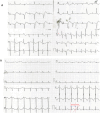Identification of a novel TECRL variant causing type 3 catecholaminergic polymorphic ventricular tachycardia
- PMID: 40453219
- PMCID: PMC12122765
- DOI: 10.3389/fped.2025.1549827
Identification of a novel TECRL variant causing type 3 catecholaminergic polymorphic ventricular tachycardia
Abstract
Background: Catecholaminergic polymorphic ventricular tachycardia (CPVT) is a leading cause of sudden cardiac death (SCD) in young patients, characterized by bidirectional or polymorphic ventricular tachycardia often induced by physical exertion or emotional stress.
Results: We analyzed a 12-year-old girl with CPVT who suffered cardiac and respiratory arrest. Clinical data were derived from medical records. Whole-exome sequencing (WES) and Sanger sequencing identified two missense mutations in the trans-2,3-enoyl-CoA reductase-like (TECRL) gene (NM_001010874.5: c.587G > A p.Arg196Gln and NM_001010874.5: c.868C > T p.Pro290Ser), potentially pathogenic and associated with type 3 CPVT (CPVT3). Functional studies suggested both mutations could lead to reduced protein expression. We also discovered a novel TECRL mutation (NM_001010874.5: c.868C > T p.Pro290Ser). This study further supports the role of TECRL as one cause of CPVT.
Conclusions: In this study, functional studies implicate these variants as the cause of CPVT in this patient.
Keywords: TECRL; catecholaminergic polymorphic ventricular tachycardia; functional analysis; long QT syndrome; pediatric; sudden cardiac death.
© 2025 Chen, Shen, Chen and Sun.
Conflict of interest statement
The authors declare that the research was conducted in the absence of any commercial or financial relationships that could be construed as a potential conflict of interest.
Figures



References
-
- Napolitano C, Mazzanti A, Bloise R, Priori SG. Catecholaminergic Polymorphic Ventricular Tachycardia. (1993).
-
- Tester DJ, Ackerman JP, Giudicessi JR, Ackerman NC, Cerrone M, Delmar M, et al. Plakophilin-2 truncation variants in patients clinically diagnosed with catecholaminergic polymorphic ventricular tachycardia and decedents with exercise-associated autopsy negative sudden unexplained death in the young. JACC-Clin Electrophy. (2019) 5:120–7. 10.1016/j.jacep.2018.09.010 - DOI - PMC - PubMed
LinkOut - more resources
Full Text Sources

